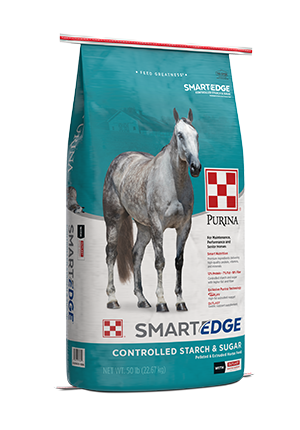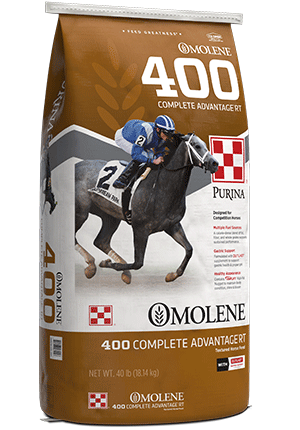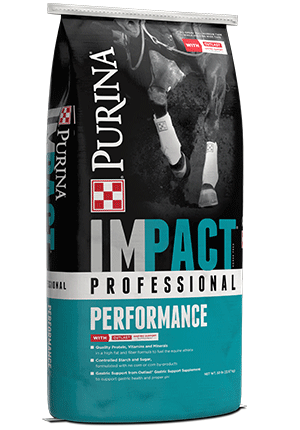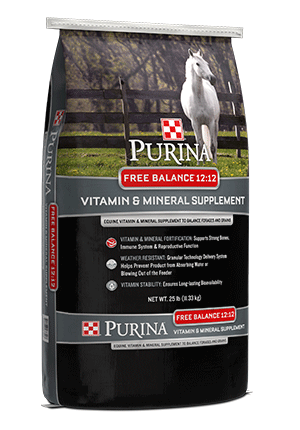
Feeding Horses for Weight Gain
Nutrition : General Nutrition

One common question asked by horse owners is “how do I put weight on a thin horse?”
There are several factors that can lead to a horse being underweight, including health conditions, age-related issues, or simply inadequate calories in the horse’s diet.When dealing with a thin horse, first we need to look at the horse’s health status. Is the horse suffering from parasites, disease, chronic pain, ulcers or dental issues? These are all issues to be addressed by your veterinarian, and making an appointment with your vet is the first step to help your horse gain weight. If weight loss is caused by a health condition, then addressing the condition may be all that is necessary to help your horse regain the lost body condition.
Your vet may suggest that your horse is getting to an age that its teeth are no longer adequate to chew long-stemmed hay, even with proper dental care. Hay is very fibrous, and as a horse ages, its teeth wear down to the point that the horse is unable to fully chew the hay, and, also with age, the horse’s digestion and absorption in the gut becomes less efficient. Therefore, what hay and feed does make it into the digestive tract does not get fully utilized. In these situations, the optimal choice is Purina® Equine Senior® horse feed. Equine Senior® was designed to contain enough roughage to be fed with minimal or no hay, so that the geriatric horse will receive sufficient nutrients to meet its requirements even without an additional forage source. The horse should be gradually switched from the current feed to Equine Senior®, and then the amount of Senior will be gradually increased to compensate for the roughage the horse is unable to eat.
There may come a time that a geriatric horse will not be able to utilize hay (or possibly even pasture) whatsoever, and will need to obtain all its nutrients from Equine Senior®. For this reason it is not uncommon to feed 15 or more pounds per day of Equine Senior® to a geriatric horse, especially if the horse is working. If the time comes when the horse’s dental condition is so poor that the horse is no longer even able to chew the soft pellets, then water can be added to the Equine Senior® to make a mash. (Note: the age at which a horse becomes a senior is determined by the horse. Some horses need to be fed Equine Senior® in their teens, others will do fine on Equine Senior® Active, Ultium® Competition, Strategy® GX, Strategy® Healthy Edge® or an appropriate Omolene® horse feed with pasture and/or hay well into their twenties.)
If the senior horse is eating recommended amounts of Equine Senior®, and still needs to gain a few pounds, there are a few options available. First, if the older horse is still well able to chew and digest pasture/hay, switching to a higher calorie feed may be a good choice. Equine® Senior Active is a high-calorie feed that is ideal for older horses that are still able to utilize long-stemmed forage. Ultium® Competition, Omolene® #200 and Omolene® #500 are also calorie-dense feeds that may be helpful to help an older horse gain weight when fed with appropriate good quality hay and/or pasture. If the horse is not able to adequately utilize hay/pasture, and is eating enough Equine Senior® to completely replace the forage in the diet, then adding Purina’s high fat supplement Amplify® may provide enough additional calories for the horse to gain weight.
In many cases, the reason a horse is underweight is that it is just not eating adequate calories. So, to put weight on a horse, first you need to determine how much the horse currently weighs and how much weight it needs to gain. An easy way to determine the horse’s body weight is to use a weight tape. The Purina equine research team has spent many years measuring horses at the Purina Animal Nutrition research farm to develop our body weight tape, which is available through your local Purina horse feed dealer. Be sure to read the directions on the tape, measure around your horse’s heart girth and determine the current weight. To decide how much weight the horse needs to gain, you also need to determine your horse’s Body Condition Score. In general, most horses should be maintained at a body condition score (BCS) of 5-6; broodmares should be 5 to 7. A BCS of 5 is a horse that you can look at from the side and not see any ribs showing, but if you run your hand along the barrel you can easily feel the ribs.
For every condition score below 5, an 1100-pound horse needs to gain about 45-50 pounds, and a 1-pound gain requires about 8000-9000 kcals over the calories required for maintenance. So, for example, if the horse needs to go from a 4 to a 5, it needs to gain 45 pounds, which is a total of approximately 380,000 kcals. Obviously, we’re not going to feed that in one day! It is safest to put weight on a horse slowly, so let’s take 90 days for this example. 45 pounds of gain in 90 days is 1/2 pound per day, a safe goal to aim for. About 4500 additional kcal per day over the normal amount fed should achieve half a pound of gain per day. This could be accomplished by adding 2 pounds of Strategy (3000 kcals) and 2 pounds of alfalfa hay (approximately 1800 kcals) per day, or maybe 2.5 pounds of Ultium (4750 kcal). As in all cases, changes need to be made gradually to reduce the risks of digestive upsets.




